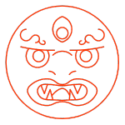
A lecture by Sangyun Han, visiting researcher at the University of Amsterdam (UvA) and PhD candidate at Tohoku University in Japan.
This lecture focuses on the revival of esoteric Buddhism in postwar Japan. Considering both the Western ‘New Age’ trend and the Japanese ‘Occult Boom’, the speaker explores how occult-related ideas influenced the reevaluation and reinterpretation of Japanese esoteric Buddhism.
This lecture takes place in the IIAS Conference room from 14:00 – 15:30 hrs. (not online).
For more info, please check: https://www.iias.asia/events/occult-and-revival-mikkyo-religious-landscape-1970s-japan
Abstract
From the perspective of global religious history, this lecture explores the revival of Mikkyō, or esoteric Buddhism, in postwar Japan. It pays special attention to Shingon Buddhism, one of the representative esoteric Buddhist schools in Japan founded in the 9th century, and its relationship with the popular trend of 1970s Japan called the “Occult Boom”. A widespread cultural phenomenon, dubbed the “Occult Boom” (okarutobūmu) by the Japanese media, was sparked by the publication of the 1973 Japanese translation of Colin Wilson’s The Occult. During this period, there was a noticeable increase in public interest in topics such as Nostradamus’ prophecies, psychic powers, and magic. This fascination with supernatural phenomena and the spiritual world was fueled by harsh critiques of “materialistic society”, combined with the widespread perception that the serious pollution problems of the time were the fault of the activities of major corporations. This era of “re-enchantment” in the 1970s was closely intertwined with the introduction of “New Age” trends from abroad. Moreover, the influence of the “Occult Boom” extended beyond popular culture. Mikkyō, which had been marginalized within Buddhist discourses in modern Japanese society due to its perceived “magical characteristics”, was also subject to reevaluation and reinterpretation in connection to occult-related subjects. This talk introduces Mikkyō theories through two prominent figures: Kiriyama Seiyū (1921–2016), the founder of Agonshū, one of the more successful post-1970s “new religions” of Japan; and Yamasaki Taikō (b. 1929), a Buddhist priest and instructor at many important educational institutions connected to the Shingon sect. By presenting their works developed during the period of the “Occult Boom,” this lecture will show how Japanese esoteric Buddhism attracted new attention in the postwar era while negotiating and intermingling with contemporary discourses on “psychic powers” and “self-cultivation”.
Sangyun Han is a PhD candidate at the Graduate School of International Cultural Studies, Tohoku University in Japan, and a visiting researcher at the HHP Centre, the University of Amsterdam. Her research focuses on the history of modern Japanese religion, especially the relationship between the “Occult Boom” of the 1970s and the revival of esoteric Buddhism in postwar Japan. Her recent articles include “The Reception and Development of the Concept of ‘the Occult’ in 1970s Japan: On the ‘Mikkyō Boom’ and its Influence” (Gakusai nihon kenkyū 1, 2021), “Historicizing the (Oc)cultic Milieu: Mikkyō in 1970s Japan” (Religious Studies in Japan volume 7, special issue, 2024). She is currently working on her dissertation, which examines the process of negotiation and entanglement between the New Age trend from the West and Japanese esoteric Buddhism, with the aim of offering a history of esotericism from an East Asian perspective.
